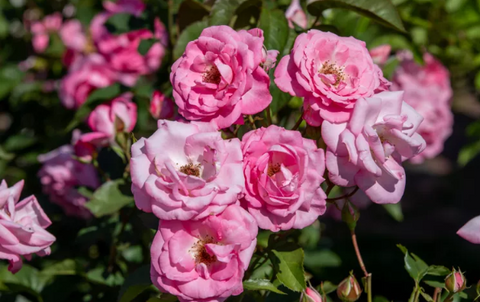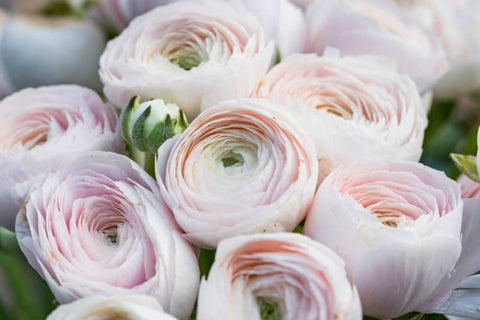Roses, often dubbed the queen of the garden, demand a regal environment. Companion planting, an age-old horticultural technique, offers a symbiotic solution to cultivate roses in their full splendor. This practice involves pairing roses with complementary plants to create a thriving, balanced ecosystem. It’s not just about aesthetics; it's about fostering a nurturing habitat that enhances the health and vitality of your roses.

Benefits of Choosing the Right Companions for Your Roses
Selecting the right companions for your roses is akin to choosing the perfect ensemble for an occasion. The benefits are manifold: improved pest control, enhanced soil fertility, and increased disease resistance. Moreover, the right companions can augment the visual appeal of your garden, providing a tapestry of colors and textures that transform it into a living masterpiece.
Selecting the Best Companions
Key Criteria for Choosing Rose Companions
When selecting companions for your roses, consider factors such as soil compatibility, sunlight exposure, and water needs. Plants that thrive in similar conditions will harmonize well with roses, ensuring a cohesive and healthy garden environment.
Matching Plant Needs: Soil, Sunlight, and Water Requirements
Roses prefer well-drained soil, ample sunlight, and consistent watering. Choose companions that share these preferences. For instance, lavender thrives in similar conditions and can enhance the fragrance and beauty of your rose garden.
The Importance of Plant Height and Spread
Consider the height and spread of companion plants to ensure they don’t overshadow your roses. Tall plants like hollyhocks can provide a stunning backdrop while low-growing ground covers like creeping thyme can fill in gaps and suppress weeds.
Companion Plants for Pest Control
Natural Pest Repellents: Plants that Keep Aphids Away
Certain plants are natural pest repellents. Garlic, chives, and marigolds are excellent choices to keep aphids and other pests at bay. These plants emit strong scents that deter unwanted insects, offering a natural form of protection for your roses.
Welcoming Beneficial Insects: Attracting Ladybugs and Hoverflies
To create a balanced ecosystem, attract beneficial insects like ladybugs and hoverflies. Plants such as dill, fennel, and yarrow provide the necessary habitat and nectar for these helpful predators, which in turn, help control aphid populations.
Deterring Deer and Rabbits with Fragrant Herbs
Fragrant herbs like rosemary, sage, and thyme are effective in deterring deer and rabbits. These animals tend to avoid strong scents, making these herbs a practical choice to protect your rose garden from foraging wildlife.
Boosting Rose Health with Companion Plants
Nitrogen Fixers: Enhancing Soil Fertility
Leguminous plants like clover and beans are nitrogen fixers, meaning they enrich the soil with essential nutrients. Interplanting these with your roses can significantly boost soil fertility, promoting robust growth and vibrant blooms.
Disease Prevention: Plants that Reduce Fungal Issues
Certain plants can reduce the risk of fungal diseases in roses. For example, garlic and chives have natural antifungal properties. By planting these allies, you can create a healthier environment for your roses, minimizing the likelihood of common fungal infections.
Improving Air Circulation: Low-Growing Ground Covers
Low-growing ground covers like sweet alyssum and creeping thyme improve air circulation around the base of rose bushes. This helps prevent fungal diseases by reducing humidity and promoting better airflow, crucial for maintaining healthy roses.

Beautiful Blooms: Aesthetic Companions for Roses
Color Combinations: Creating a Stunning Floral Display
Pairing roses with plants that have complementary colors can create a visually stunning display. Think of the rich purple hues of catmint or the vibrant oranges of marigolds juxtaposed against the classic beauty of rose blossoms. Such combinations can transform your garden into a vivid tapestry.
Seasonal Interest: Plants that Provide Year-Round Beauty
To maintain visual interest throughout the year, choose companions that bloom in different seasons. Spring bulbs like daffodils and tulips provide early color, while perennials like echinacea and yarrow ensure continued interest into the summer and fall.
Textural Contrast: Adding Variety to Your Garden
Incorporating plants with diverse textures can add depth and intrigue to your garden. The feathery foliage of ornamental grasses, the bold leaves of hostas, and the delicate blooms of cosmos all contribute to a rich, varied garden landscape.
Herbs as Rose Companions
Lavender: The Perfect Pair for Fragrance and Pest Control
Lavender not only complements roses aesthetically but also serves as an effective pest deterrent. Its strong scent repels pests, while its purple blooms add a striking contrast to the vibrant hues of roses.
Sage and Thyme: Culinary Delights with Protective Qualities
Sage and thyme are excellent companions for roses. These herbs offer culinary benefits and their aromatic properties deter many pests. Planting them near your roses can provide a dual benefit of protection and productivity.
Chives and Garlic: Unexpected Allies in Disease Prevention
Chives and garlic are more than just kitchen staples; they are powerful allies in the garden. Their natural antifungal properties help prevent diseases such as black spot and mildew, common afflictions of roses.
Perennials to Plant with Roses
Echinacea: Adding Vibrancy and Attracting Pollinators
Echinacea, with its vibrant blooms, not only adds a splash of color but also attracts pollinators. Bees and butterflies flock to its nectar-rich flowers, enhancing the pollination of your roses and other garden plants.
Catmint: A Hardy, Low-Maintenance Choice
Catmint is a hardy, low-maintenance perennial that pairs beautifully with roses. Its lavender-blue flowers and aromatic foliage deter pests and its sprawling habit provides excellent ground cover, reducing weed competition.
Yarrow: The Ultimate Multi-Tasker
Yarrow is a versatile companion plant. Its clusters of tiny flowers attract beneficial insects, while its deep roots improve soil structure. Yarrow’s drought tolerance and long blooming season make it a practical and attractive choice for any rose garden.

Annual Companions for Quick Results
Marigolds: The Powerhouse of Pest Deterrence
Marigolds are a gardener’s best friend when it comes to pest control. Their strong scent deters a wide range of pests, and they are known to improve soil health by suppressing nematodes, making them a powerhouse companion for roses.
Nasturtiums: Vibrant, Edible, and Beneficial
Nasturtiums bring vibrant colors and edible flowers to the garden. They act as a trap crop, attracting aphids away from roses, and their peppery leaves can be used in salads, adding both beauty and utility to your garden space.
Cosmos: Adding Height and Grace
Cosmos are tall, graceful annuals that add height and a touch of elegance to a rose garden. Their airy foliage allows for good air circulation, and their bright flowers attract pollinators, supporting the health of your roses.
Companion Shrubs and Small Trees
Boxwood: A Classic Border for Rose Beds
Boxwood shrubs create a classic, formal border for rose beds. Their dense, evergreen foliage provides a beautiful contrast to the delicate blooms of roses, while also serving as a windbreak and shelter for beneficial insects.
Buddleia: The Butterfly Magnet
Buddleia, or butterfly bush, lives up to its name by attracting hordes of butterflies. Planting it near your roses can enhance pollination, and its fragrant, cone-shaped blooms add a vertical element to your garden design.
Lilac: For a Romantic, Cottage-Garden Feel
Lilacs, with their intoxicating fragrance and lush, romantic blooms, are perfect companions for roses. Their early spring blossoms provide a beautiful backdrop for later-blooming roses, creating a layered, cottage-garden aesthetic.
Companion Ground Covers
Creeping Thyme: A Fragrant, Low-Growing Choice
Creeping thyme is a fragrant, low-growing ground cover that fills in gaps between rose bushes. Its tiny purple flowers attract pollinators, while its dense growth suppresses weeds and improves soil structure.
Sweet Alyssum: Carpet of Flowers with a Sweet Scent
Sweet alyssum forms a carpet of tiny, sweet-scented flowers that attract beneficial insects and provide ground cover. Its delicate blooms add a soft, ethereal quality to the garden, complementing the bold beauty of roses.
Clover: Enhancing Soil Health Naturally
Clover is an excellent ground cover that enhances soil health. Its nitrogen-fixing properties enrich the soil, promoting the growth of nearby roses. Clover’s resilience and ability to thrive in various conditions make it a practical choice for any garden.

Companion Grasses
Ornamental Grasses: Adding Movement and Softness
Ornamental grasses bring movement and a soft, flowing texture to a rose garden. Varieties like fountain grass and miscanthus can add height and contrast, their swaying blades creating a dynamic backdrop for static rose bushes.
Blue Fescue: Compact and Colorful
Blue fescue is a compact, colorful grass that pairs well with roses. Its blue-green tufts provide a striking contrast to the vibrant colors of rose blooms, adding both texture and visual interest to your garden.
Fountain Grass: For a Dramatic Effect
Fountain grass, with its arching, feathery plumes, adds a dramatic effect to rose beds. Its movement in the breeze brings a sense of life and vitality to the garden, enhancing the overall aesthetic appeal.
Bulbs and Tubers for Rose Gardens
Daffodils: Early Bloomers for Spring Interest
Daffodils are early bloomers that herald the arrival of spring. Their bright yellow flowers provide a cheerful contrast to the emerging foliage of roses, creating a vibrant display that signals the garden’s awakening.
Tulips: Vibrant Colors to Complement Roses
Tulips offer a wide range of vibrant colors that complement the hues of roses. Planting tulips around rose bushes creates a stunning springtime display, bridging the gap between the seasons and keeping the garden lively.
Alliums: Architectural Beauty and Pest Deterrence
Alliums bring architectural beauty with their spherical blooms perched atop tall stalks. They also serve as natural pest deterrents, their strong scent repelling pests such as aphids and borers, making them a valuable addition to any rose garden.
Native Plants as Rose Companions
Benefits of Using Native Plants
Using native plants as companions for roses offers numerous benefits. Native plants are better adapted to the local climate and soil conditions, requiring less care. They also support local wildlife, providing habitat and food sources for native pollinators and beneficial insects.
Popular Native Companions for Different Regions
Selecting native plants that complement roses can vary by region. For example, in North America, coneflowers and black-eyed Susans make excellent companions. In the Mediterranean, lavender and rosemary thrive alongside roses, offering both beauty and practicality.
Gardening with rose companions brings immense joy and satisfaction. Watching your garden flourish with a diverse array of plants enhances the beauty and health of your roses, creating a harmonious and vibrant environment.
Don’t be afraid to experiment with different plant combinations and personalize your garden. Each garden is unique, and the best way to discover what works is through trial and error. Let your creativity and intuition guide you.









